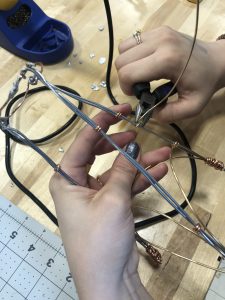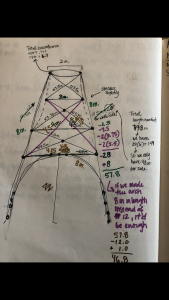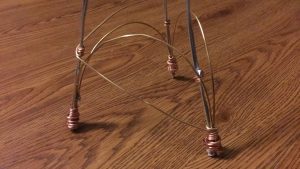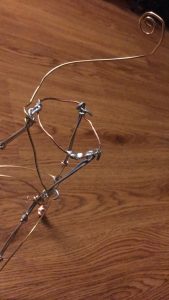In approaching this assignment, we first considered what concepts the masters of metalworking must bring into their projects, despite having no mastery of metals ourselves. Foremost, we thought about their understanding of the medium: how metals conduct heat, how easily certain metals can be manipulated and bent, and how  sturdy certain metals are when expected to bear weight. After our demonstration in the Makerspace, we had a fairly good sense of the malleability of the copper and
sturdy certain metals are when expected to bear weight. After our demonstration in the Makerspace, we had a fairly good sense of the malleability of the copper and  bronze wire, and assumed that the steel wire would surpass them both in sturdiness. We then began thinking through what we would have to do as we made the structure. We knew we would likely begin the process by cutting the wire, bending it, and ultimately spend most of our time soldering the pieces together.
bronze wire, and assumed that the steel wire would surpass them both in sturdiness. We then began thinking through what we would have to do as we made the structure. We knew we would likely begin the process by cutting the wire, bending it, and ultimately spend most of our time soldering the pieces together.
Keeping all of these properties in mind, we moved into the design phase of the assignment. Knowing that the final aesthetic of our structure would be one of exposed wire, we began brainstorming other structures we knew of comprised of exposed metal.Our minds immediately went to the Eiffel Tower, a metal structure we all knew as an engineering feat. We designed a simplified version of it, still utilizing the crossing support beams and the triangle. As we were measuring the wire we were given, we realized that, to execute a design like the tower, our structure would have to be three sides and that it would need to be simplified even more than our original design. In this planning, we would use almost all of the wire provided.
Upon arriving to the makerspace to start the project, we realized that soldering the amount of wire pieces we had planned to facilitate maximum support would be extremely challenging. The solder was not sticking to the copper, bronze, and stainless steel easily and we were only able to get it to stick if we clumped it on so that it engulfed the ends of both pieces that we were trying to connect. The Makerspace employees were not appreciative of this method. Because of these issues, and the realization that the stainless steel was bearing much more weight than we had originally thought, we began to rethink our design to go for something that was less pieces and more reliant on coils. We realized that the copper was very structurally effective when put to use as coils on the base and up
and more reliant on coils. We realized that the copper was very structurally effective when put to use as coils on the base and up  the sides of the stainless steel, especially when slightly soldered on. This allowed us to solder much less while still creating a Eiffel Tower-like structure that could support more than enough weight.
the sides of the stainless steel, especially when slightly soldered on. This allowed us to solder much less while still creating a Eiffel Tower-like structure that could support more than enough weight.
After putting together the stainless steel base of our structure, it was time to attach the copper hoop that the Dixie cup would sit in. Our first approach to this attachment was to simply twist the stainless steel around the copper hoop, but in doing so realized that this caused the hoop to lose its shape. To keep the shape of the ring while still ensuring that the placement would be stable, we placed the copper ring between the stainless steel wires and coiled it around the ring, soldering where we thought necessary. Upon testing out the stability of our structure, we found that placing weight in the cup caused the structure to lean sideways, so we countered this by using our final bronze wire as reinforcements that around the entire structure. This reinforcement differed from our original plan in that we refrained from cutting it up into smaller pieces, taking advantage of its strength as a single wire, and attaching it by coiling it around the steel bases. The bronze wire provided both necessary support, and ornament to our whimsical Eiffel Tower.
The aesthetic elements of our structure are derived from the use of coils as both decoration and support. Knowing we would have little wire left over after planning, we were limited in the amount of wire that could be attributed to solely aesthetic purposes. While making our structure, we found that the copper coils around the steel, as well as the bronze wire that traveled up the piece, gave our structure a fairy-tale like quality, which we chose to emphasize with the addition of a decorative coil at the end of the bronze wire.